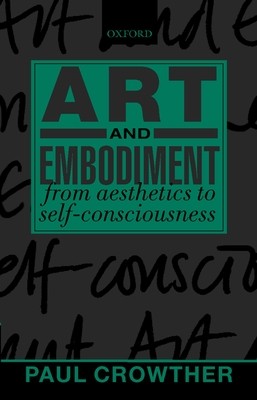
- We will send in 10–14 business days.
- Author: Paul Crowther
- Publisher: Oxford University Press, USA
- ISBN-10: 0199244979
- ISBN-13: 9780199244973
- Format: 13.8 x 22 x 1.3 cm, minkšti viršeliai
- Language: English
- SAVE -10% with code: EXTRA
Reviews
Description
In his Critical Aesthetics and Postmodernism, Paul Crowther argued that art and aesthetic experiences have the capacity to humanize. In Art and Embodiment he develops this theme in much greater depth, arguing that art can bridge the gap between philosophy's traditional striving for generality and completeness, and the concreteness and contingency of humanity's basic relation to the world. As the key element in his theory, he proposes an ecological definition of art. His strategy involves first mapping out and analyzing the logical boundaries and ontological structures of the aesthetic domain. He then considers key concepts from this analysis in the light of a tradition in Continental philosophy (notably the work of Kant, Heidegger, Merleau-Ponty, and Hegel) which--by virtue of the philosophical significance that it assigns to art--significantly anticipates the ecological conception. On this basis, Crowther is able to give a full formulation of his ecological definition. Art, in
making sensible or imaginative material into symbolic form, harmonizes and conserves what is unique and what is general in human experience. The aesthetic domain answers basic needs intrinsic to self-consciousness itself, and art is the highest realization of such needs. In the creation and reception of art the embodied subject is fully at home with his or her environment.
EXTRA 10 % discount with code: EXTRA
The promotion ends in 21d.06:55:53
The discount code is valid when purchasing from 10 €. Discounts do not stack.
- Author: Paul Crowther
- Publisher: Oxford University Press, USA
- ISBN-10: 0199244979
- ISBN-13: 9780199244973
- Format: 13.8 x 22 x 1.3 cm, minkšti viršeliai
- Language: English English
In his Critical Aesthetics and Postmodernism, Paul Crowther argued that art and aesthetic experiences have the capacity to humanize. In Art and Embodiment he develops this theme in much greater depth, arguing that art can bridge the gap between philosophy's traditional striving for generality and completeness, and the concreteness and contingency of humanity's basic relation to the world. As the key element in his theory, he proposes an ecological definition of art. His strategy involves first mapping out and analyzing the logical boundaries and ontological structures of the aesthetic domain. He then considers key concepts from this analysis in the light of a tradition in Continental philosophy (notably the work of Kant, Heidegger, Merleau-Ponty, and Hegel) which--by virtue of the philosophical significance that it assigns to art--significantly anticipates the ecological conception. On this basis, Crowther is able to give a full formulation of his ecological definition. Art, in
making sensible or imaginative material into symbolic form, harmonizes and conserves what is unique and what is general in human experience. The aesthetic domain answers basic needs intrinsic to self-consciousness itself, and art is the highest realization of such needs. In the creation and reception of art the embodied subject is fully at home with his or her environment.


Reviews